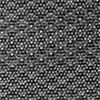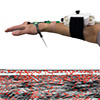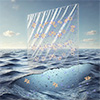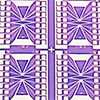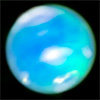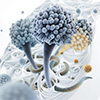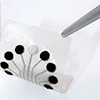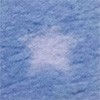Mar 27, 2025 Researchers discovered brand new interference patterns in twisted two-dimensional tungsten ditelluride lattices. These patterns can be tuned to look like periodic spots or even one-dimensional bands by adjusting the twist angle between layers, and they can drastically alter the physical properties of the material. (Nanowerk News) One...
Humans as hardware: computing with biological tissue
Mar 27, 2025 Researchers show that human tissue can be used to process data and perform computational tasks. (Nanowerk News) Most computers run on microchips, but what if we’ve been overlooking a simpler, more elegant computational tool all this time? In fact, what if we were the computational tool? As...
Plastic-like materials that dissolve in the sea
Mar 27, 2025 Supramolecular materials that fully degrade when soaked in saltwater have the potential to help address the microplastics pollution crisis. (Nanowerk News) Microplastics—small fragments of plastics less than 5mm across—now infiltrate every corner of our planet, from remote regions of the deep ocean and the Arctic, to the...
Automated large-scale graphene transfer boosts chip production for molecular diagnostics
Mar 26, 2025 Automated glass-chamber system transfers graphene from copper to wafers using fluid cycles, enabling precise, hands-free chip production like a miniature assembly line. (Nanowerk News) A team led by Delphine Bouilly, a professor in UdeM's Physics Department and director of IRIC’s Electronic Nanobiosensor Design and Application Research Unit,...
Magnetic tweezers make robotic surgery safer, more precise
Mar 26, 2025 Researchers have created a magnetic tweezer system that could one day make it possible for doctors to do remote, non-invasive, highly precise medical procedures on their patients using a microrobot. (Nanowerk News) Imagine if a doctor could remotely do a non-invasive, highly precise medical procedure on her...
Webb captures Neptune’s auroras for first time
Mar 26, 2025 Neptune was the missing piece of the puzzle when it came to detecting auroras on the giant planets of our solar system. (Nanowerk News) For the first time, NASA’s James Webb Space Telescope has captured bright auroral activity on Neptune. Auroras occur when energetic particles, often originating...
Webb sees galaxy mysteriously clearing fog of early universe
Mar 26, 2025 Astronomers discovered bright hydrogen emissions from an ancient galaxy, puzzling researchers over how this light pierced the universe's early hydrogen fog. (Nanowerk News) Using the unique infrared sensitivity of NASA’s James Webb Space Telescope, researchers can examine ancient galaxies to probe secrets of the early universe. Now,...
Nanomedicine with siRNA shows first effectiveness against the human-pathogenic fungus Aspergillus fumigatus
Mar 26, 2025 The study demonstrates that this RNAi approach shuts down vital fungal genes, thereby inhibiting pathogen growth - a groundbreaking step in the development of new antifungal therapies. (Nanowerk News) Fungal infections are on the rise globally. According to a study by the Manchester Fungal Infection Group, in...
Sensor technology uses nature’s blueprint and machinery to monitor metabolism in body
Mar 26, 2025 Researchers developed an advanced sensor platform that measures metabolites - key molecules involved in sustaining life through metabolism - inside the body in real time. (Nanowerk News) Life’s essential functions are powered by a set of compounds called metabolites, which are involved in every natural process including...
New light-induced polymer material formation method to improve 3D printing resolution
Mar 26, 2025 Scientists developed a new photopolymerisation reaction controlled antagonistically by two different colours of light. Specifically, one light beam promotes the formation of the polymeric material, while another beam halts the reaction. (Nanowerk News) At present, 3D printing is an increasingly widespread and accessible technology, typically involving the...

